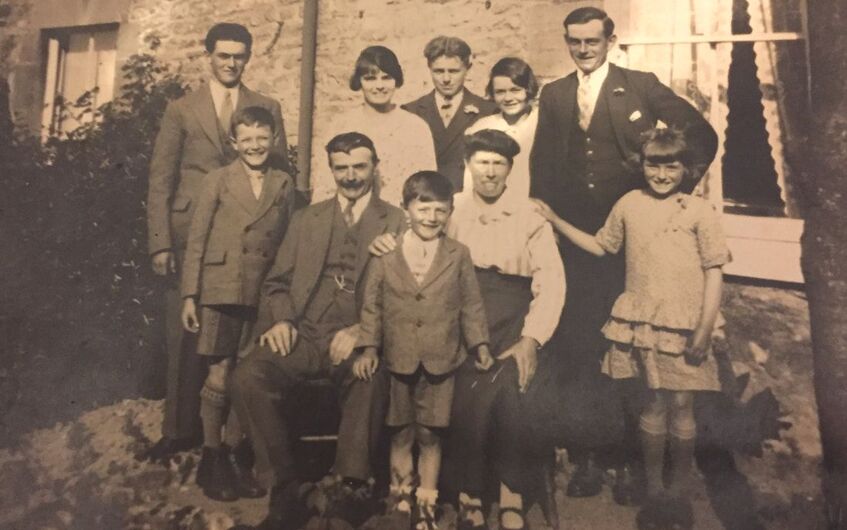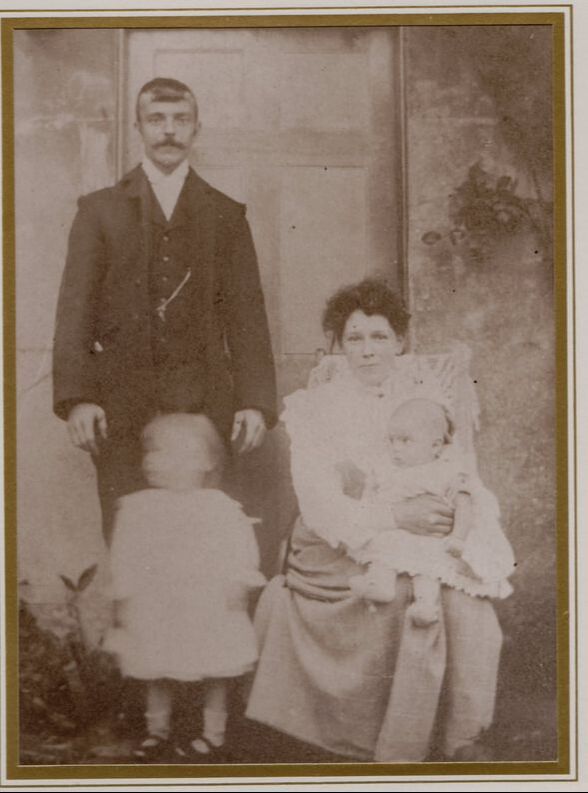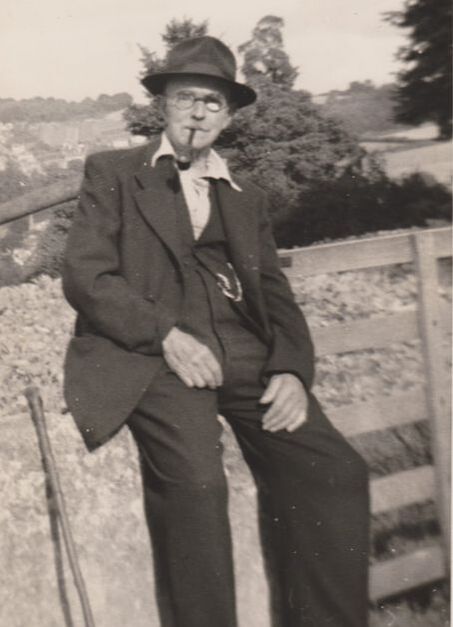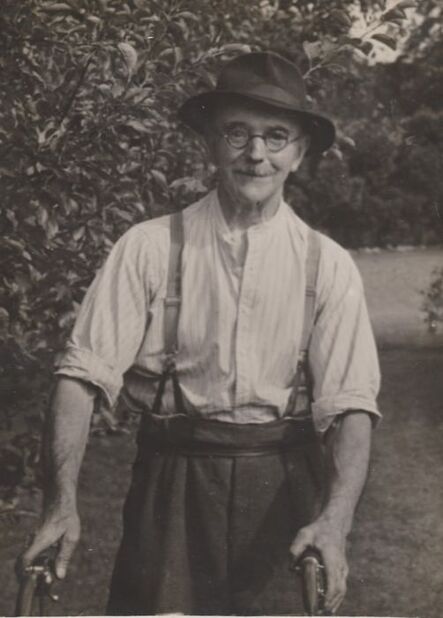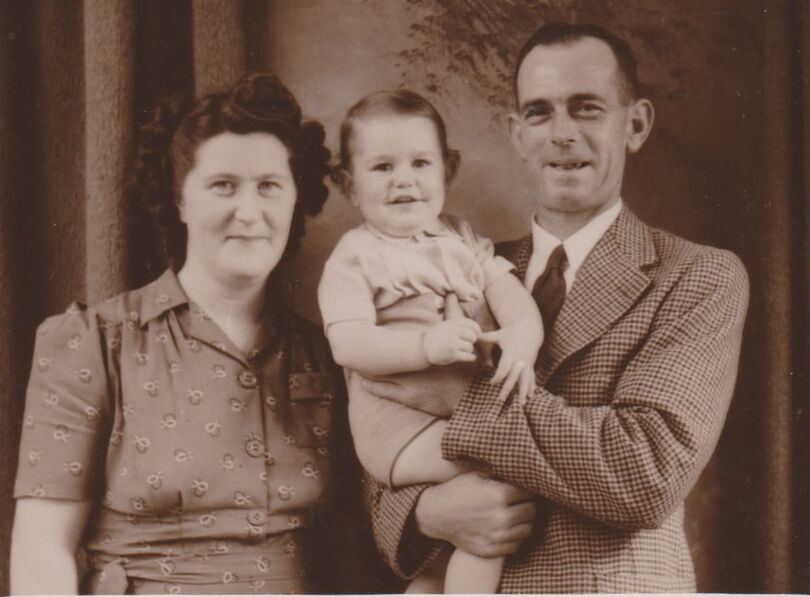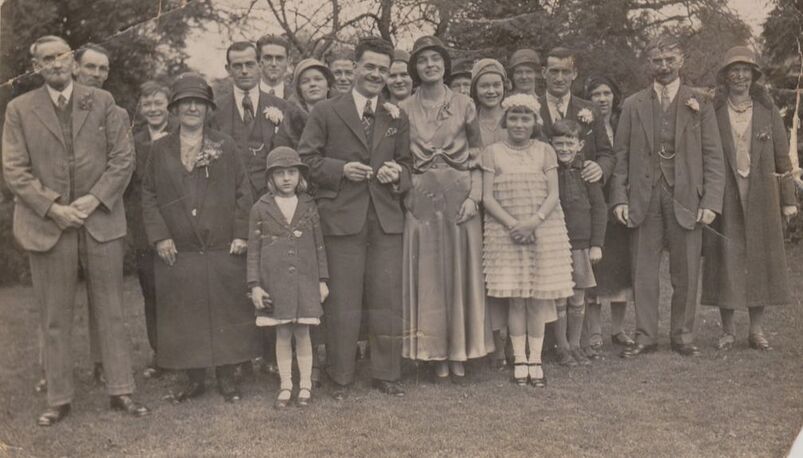Currant Family Text and photos John Currant April 2022
Sometimes a story reflects many generations of the same village family. This seems to be the case with the Currant family who have lived in Box for a century and a half but that isn’t the full story. John Currant and his mother were both born in Wales and John’s memories of Box date from his childhood during 1952-53 when his branch of the family moved from Chippenham to the newly-built 21 Brunel Way. He went to Box School for a couple of years, then to Chippenham Grammar, until he left the village in 1961 to work in London. But Box was the Currant family home and where John decided to return when he retired. This is his family story.
The earliest documented reference to the Currant family was in 1776 when Edward Currant married Margaret Simpkins at Bremhill. The records then enable us to trace a family tree down to the present, a rare example of continuity in North Wiltshire in villages including Bremhill, Yatton Keynell, Biddestone. The men worked as agricultural labourers, as most did at that time. Although it is tempting to suggest that they were involved in the dairy industry of North Wiltshire, there is no evidence of the nature of their work and two generations at least lived in Biddestone, a village dominated by tillage rather than dairy farming. There are family anecdotes that an ancestor worked as a carter with horse and carriage.
Edward Currant, blacksmith
At one time, the Currant family were known as the blacksmiths of Ashley. They came to Box when my great grandfather
Edward (1838–1916) moved to the village on his marriage to Ann Tye of The Barton, Ashley on 2 January 1869 and they lived next door to Ann’s parents, William and Sarah Tye, at The Barton.[1] We know from the marriage certificate that Ann was literate but Edward could only make his mark. It was the start of the family’s connection with the village but the couple had no children themselves and Ann died within four years of the marriage. Instead, it was Edward’s second marriage to Rosa Ann Bright from Abingdon, Berkshire, in 1876, which forged the family connection with Box, where they had three children in four rooms at 5 The Barton.[2]
In the 1881 census, Edward was living at Ashley with his family, working as a blacksmith. We might imagine Edward’s life was one of hard physical labour, overcrowding at home and financial hardship. These conditions took a toll on both Edward and Rosa and their family and their eldest child, Edward Frederick (known as Ted), was reported to suffer from a spinal complaint.[3]
The youngest child, Alice, never married but stayed at home to look after her parents who were later described as more or less crippled, though the father (aged 73) earned a little as a blacksmith.[4]
The family were prosecuted in 1888 for failing to ensure their eldest boys were receiving an efficient education up to the age of fourteen.[5] In their defence, they claimed that Edward Frederick went to a boarding school but left when he was bullied and that both boys now attended a dame school. Foster’s Education Act of 1870, the great break-through in establishing an English national education system, often faced opposition from parents, who saw no need for learning when children could be taught a trade at home and we might imagine that Edward senior wanted his son to help in the smithy doing much of the manual work. Foster’s Act established local boards to supervise the system and Mr Vezey, clerk to the Box Schools, brought the case against the Currants. In the 1891 census Edward, Rosa Ann and their family were renting property at Yatton Road, Biddeston, although it is not known if the court case was the reason for the temporary move as they were back in The Barton in 1901 and 1911.
The life of the oldest son, Edward Frederick, was dogged with problems. He trained as a blacksmith with his father but the work was too physically demanding for him and he took employment as a sawyer at the Ashley Steam Sawmills. The new job ended in tragedy in 1913 when thirty-six-year-old Edward had an accident that killed him. The incident could have related to the use of a steam-driven traction engine to drive the cutting machinery. His parents were paid compensation for their loss amounting to £90.10s as their son was the main wage-earner in the house. Curiously they were represented by Mr Vezey, the same man who had prosecuted them over school attendance.[6]
The earliest documented reference to the Currant family was in 1776 when Edward Currant married Margaret Simpkins at Bremhill. The records then enable us to trace a family tree down to the present, a rare example of continuity in North Wiltshire in villages including Bremhill, Yatton Keynell, Biddestone. The men worked as agricultural labourers, as most did at that time. Although it is tempting to suggest that they were involved in the dairy industry of North Wiltshire, there is no evidence of the nature of their work and two generations at least lived in Biddestone, a village dominated by tillage rather than dairy farming. There are family anecdotes that an ancestor worked as a carter with horse and carriage.
Edward Currant, blacksmith
At one time, the Currant family were known as the blacksmiths of Ashley. They came to Box when my great grandfather
Edward (1838–1916) moved to the village on his marriage to Ann Tye of The Barton, Ashley on 2 January 1869 and they lived next door to Ann’s parents, William and Sarah Tye, at The Barton.[1] We know from the marriage certificate that Ann was literate but Edward could only make his mark. It was the start of the family’s connection with the village but the couple had no children themselves and Ann died within four years of the marriage. Instead, it was Edward’s second marriage to Rosa Ann Bright from Abingdon, Berkshire, in 1876, which forged the family connection with Box, where they had three children in four rooms at 5 The Barton.[2]
In the 1881 census, Edward was living at Ashley with his family, working as a blacksmith. We might imagine Edward’s life was one of hard physical labour, overcrowding at home and financial hardship. These conditions took a toll on both Edward and Rosa and their family and their eldest child, Edward Frederick (known as Ted), was reported to suffer from a spinal complaint.[3]
The youngest child, Alice, never married but stayed at home to look after her parents who were later described as more or less crippled, though the father (aged 73) earned a little as a blacksmith.[4]
The family were prosecuted in 1888 for failing to ensure their eldest boys were receiving an efficient education up to the age of fourteen.[5] In their defence, they claimed that Edward Frederick went to a boarding school but left when he was bullied and that both boys now attended a dame school. Foster’s Education Act of 1870, the great break-through in establishing an English national education system, often faced opposition from parents, who saw no need for learning when children could be taught a trade at home and we might imagine that Edward senior wanted his son to help in the smithy doing much of the manual work. Foster’s Act established local boards to supervise the system and Mr Vezey, clerk to the Box Schools, brought the case against the Currants. In the 1891 census Edward, Rosa Ann and their family were renting property at Yatton Road, Biddeston, although it is not known if the court case was the reason for the temporary move as they were back in The Barton in 1901 and 1911.
The life of the oldest son, Edward Frederick, was dogged with problems. He trained as a blacksmith with his father but the work was too physically demanding for him and he took employment as a sawyer at the Ashley Steam Sawmills. The new job ended in tragedy in 1913 when thirty-six-year-old Edward had an accident that killed him. The incident could have related to the use of a steam-driven traction engine to drive the cutting machinery. His parents were paid compensation for their loss amounting to £90.10s as their son was the main wage-earner in the house. Curiously they were represented by Mr Vezey, the same man who had prosecuted them over school attendance.[6]
|
Edward George Currant It was Edward and Rosas’s younger son, Edward George always known as George (1878–1955), my grandfather, who became head of the family. In 1902 young George was working as a quarryman when he married Ella Louise Norris (born in Hindon, near Tisbury, in October 1874 and died in June 1953). They took the tenancy of 1 Wilton Cottages, a 4-roomed house, where they had eleven children. George left the quarry trade probably when the industry declined in 1904 and he joined the railways as a packer, a line engineer levelling the track. This was a much more secure employment and possibly the date that they took the tenancy of Wilton Cottage. The railway job was very physical, involving lifting the sleepers and packing new ballast underneath. Later he was promoted to being a platelayer, inspecting and maintaining the rails. The employment offered a regular income with a responsible employer, the Great Western Railway, a job for life. Edward George and Ella with toddler Winnie and infant Effie in 1904 |
We get more details of their house in 1912, where they were listed as tenants paying £8.10s a year to the landlord, the Northey family. The cottage was described as stone-built and tiled (roof), having capital gardens, water supplied by well (in other words, without internal running water).[7] Incidentally, the well was still there when I was a child in 1955. Partly because there were eleven children, the family were very prominent in activities in Box during the second half of the twentieth century.
Grandfather George Currant who worked as gardener at the Northey Arms after he retired from the GWR
George and Ella’s Family
We can see how society was moving forward in the early years of the twentieth century. No longer was the majority of the workforce employed as agricultural labourers or quarrymen because education could offer more secure opportunities. Of George and Ella’s eleven children, Effie became a teacher at Corsham; Sonny and Fred joined their father working for the railways; and Stan took employment as a postman.
At the outbreak of the Second World War, many of the family were still living at 1 Wilton Cottages including George himself, described as at home through bad sight and cared for by his wife Ella; their children Arthur George (usually known as Sonny), a GWR employee; Phyllis making gas masks (at Melksham); and Evelyn, aged 18, a clerk at Melksham Rubber Works. Most railway staff were exempted from military duty, their role being to ensure the movement of military staff and ammunitions. Whilst obviously less dangerous than service on the front line, the risk of Luftwaffe attack was not insignificant.
Other members of the family were scattered around in 1939: Stanley was a gardener in Ford where his first wife Ellen was a general stores shopkeeper. He was very popular and memorial lamps were installed in the chancel of Box Church in 1984.[8] Edith Elizabeth married Stanley Henry Cuthbert Turner at West Ham, Essex (now Greater London), on 17 September 1934. Stanley was born in West Ham in 1912, later living in Ilford, Essex, where he was described in 1939 as a monumental mason and engraver (travelling).
We can see how society was moving forward in the early years of the twentieth century. No longer was the majority of the workforce employed as agricultural labourers or quarrymen because education could offer more secure opportunities. Of George and Ella’s eleven children, Effie became a teacher at Corsham; Sonny and Fred joined their father working for the railways; and Stan took employment as a postman.
At the outbreak of the Second World War, many of the family were still living at 1 Wilton Cottages including George himself, described as at home through bad sight and cared for by his wife Ella; their children Arthur George (usually known as Sonny), a GWR employee; Phyllis making gas masks (at Melksham); and Evelyn, aged 18, a clerk at Melksham Rubber Works. Most railway staff were exempted from military duty, their role being to ensure the movement of military staff and ammunitions. Whilst obviously less dangerous than service on the front line, the risk of Luftwaffe attack was not insignificant.
Other members of the family were scattered around in 1939: Stanley was a gardener in Ford where his first wife Ellen was a general stores shopkeeper. He was very popular and memorial lamps were installed in the chancel of Box Church in 1984.[8] Edith Elizabeth married Stanley Henry Cuthbert Turner at West Ham, Essex (now Greater London), on 17 September 1934. Stanley was born in West Ham in 1912, later living in Ilford, Essex, where he was described in 1939 as a monumental mason and engraver (travelling).
Phyllis married Gilbert Clarence Cawte (1910–1987) in 1940. Gilbert was born in Corsham, son of Charles George and Catherine Annie, who ran a plumbing business from the High Street, Corsham. The family were well-known in the town where Gilbert’s grandfather George ran Cawte’s Garage next to the Methuen Arms (later pulled down to make a car park). Charles owned one of the earliest motor vehicles, registration AM 610 registered to Charles as a Plumber, Glazier, Decorator and Gas & Hot Water Fitter.
Effie (15 April 1904-2000) was a history and religious affairs teacher at Corsham for forty years, first at Corsham County then at the Secondary Modern School before transferring to the new Boys’ School between 1961 and 1964. In her youth, she was a keen amateur actress performing in the Box Church Players’ Guild with the Rev George Foster and his wife. She married Douglas H Hancock (1898–1965), a foreman at the Avon Rubber Works, in 1932. Michael Rumsey was taught by her and he described her as a wonderful teacher, her lessons were well planned .. a kind and generous person who paid out of her own pocket for poorer pupils to go on school trips After Douglas’ death, she married Colin Anderson and they moved to the Forest of Dean. After she was widowed, she returned to the Claremont Nursing Home, where she died aged 96 in 2000.
The story of Walter Macdonald Currant is a tragic story of how warfare brings out the worst behaviour in people and 21-year-old Walter was killed in the evacuation from Dunkirk. His story is told in a separate article.
Effie (15 April 1904-2000) was a history and religious affairs teacher at Corsham for forty years, first at Corsham County then at the Secondary Modern School before transferring to the new Boys’ School between 1961 and 1964. In her youth, she was a keen amateur actress performing in the Box Church Players’ Guild with the Rev George Foster and his wife. She married Douglas H Hancock (1898–1965), a foreman at the Avon Rubber Works, in 1932. Michael Rumsey was taught by her and he described her as a wonderful teacher, her lessons were well planned .. a kind and generous person who paid out of her own pocket for poorer pupils to go on school trips After Douglas’ death, she married Colin Anderson and they moved to the Forest of Dean. After she was widowed, she returned to the Claremont Nursing Home, where she died aged 96 in 2000.
The story of Walter Macdonald Currant is a tragic story of how warfare brings out the worst behaviour in people and 21-year-old Walter was killed in the evacuation from Dunkirk. His story is told in a separate article.
Conclusion
When Effie married Douglas Hancock in 1932 the newspaper described it as the wedding of an old Box family.[9] They were right in their description, the Currant family have lived in North Wiltshire for nearly 250 years and in Box for over 100 years. They became a regular feature of Box life and contributed to village activities during that period. Now three-quarters of a century later, only a few members of the family still live in the village and the world that most of them knew as blacksmiths, railwaymen and stewards of a British Legion has disappeared. In a later issue, we have articles about Sonny Currant, a railway ganger,
Olive Currant, wartime nurse at Kingsdown House, Walter Macdonald Currant, killed at Dunkirk, and Life at Comrades Club.
When Effie married Douglas Hancock in 1932 the newspaper described it as the wedding of an old Box family.[9] They were right in their description, the Currant family have lived in North Wiltshire for nearly 250 years and in Box for over 100 years. They became a regular feature of Box life and contributed to village activities during that period. Now three-quarters of a century later, only a few members of the family still live in the village and the world that most of them knew as blacksmiths, railwaymen and stewards of a British Legion has disappeared. In a later issue, we have articles about Sonny Currant, a railway ganger,
Olive Currant, wartime nurse at Kingsdown House, Walter Macdonald Currant, killed at Dunkirk, and Life at Comrades Club.
Family Tree
Edward Currant married Margaret Simpkins on 17 June 1776 at Bremhill, where Margaret was born. Children: Jonathan (1777–1845); Ann (b 1784); James (b 1789).
Jonathan (1777 at Bremhill–1845) married Sarah Townsend (b 1783 at Studley-1862) on 22 May 1804 at Bremhill. Jonathan was an agricultural labourer. Children:
John (1804-1882) was an agricultural labourer who married Hannah Gale (1807–1864) at Yatton Keynell in 1839. After Hannah’s death John married Martha Bence (1818 - 1888) at Yatton Keynell in 1872; Edward (1806 – 1875); Ann (b 1809) married Charles Barnes (born Biddestone 1807) at Biddestone in 1828. Charles was an agricultural labourer; Jonathan (b 1812); Jane (born 1814 was baptised at Calne); Hannah (1817–1891) married William Butler (born in Biddestone in 1816-1897) in 1839 at Biddestone.
Edward (b 1806 at Studley–1875) married on 25 September 1826 Harriett Hulbert (b 7 February 1804 at Biddestone-d 1884). They lived in the parish of St Nicholas, Biddestone in 1851 and 1861. Children: Mary (b 1827); Elizabeth (1828-1855), a domestic servant to John and Ann Little in 1851; Ellen (1830-1886) married James Humphries (1835-1909) in 1857 and they lived at Cuttle Lane, Biddestone in 1871; Sarah (b 1833), a servant to farmers Daniel and Jane Sargent, Alderton, Malmesbury in 1851; Catherine (1835-1875) married Charles Wicks, agricultural labourer, in 1854. They had eleven children but at least three died in infancy. Charles remarried after Catherine’s death; Jonathan (b 1838 but died in infancy 1839); Edward (1839–1916); Ann (b 1842), married Alfred Humphry (b 1843 in Allington, Chippenham); and Maria (b 1844-1921), married George Baker (b 1839 at Slaughterford, d 1921).
Edward (2 December 1838 at Biddestone–18 April 1916) married Ann Tye (b 1847 at Box–11 October 1873) in 1869. They had no children. Edward married Rosa Ann Bright (30 January 1854 at Abingdon, Berkshire–8 June 1939) on 2 October 1876. Children:
Edward George known as George (12 September 1878 at Box–December 1955) married Ella Louise Norris (15 September 1878–24 April 1953) in April 1902. They had 11 children:
Edward Currant married Margaret Simpkins on 17 June 1776 at Bremhill, where Margaret was born. Children: Jonathan (1777–1845); Ann (b 1784); James (b 1789).
Jonathan (1777 at Bremhill–1845) married Sarah Townsend (b 1783 at Studley-1862) on 22 May 1804 at Bremhill. Jonathan was an agricultural labourer. Children:
John (1804-1882) was an agricultural labourer who married Hannah Gale (1807–1864) at Yatton Keynell in 1839. After Hannah’s death John married Martha Bence (1818 - 1888) at Yatton Keynell in 1872; Edward (1806 – 1875); Ann (b 1809) married Charles Barnes (born Biddestone 1807) at Biddestone in 1828. Charles was an agricultural labourer; Jonathan (b 1812); Jane (born 1814 was baptised at Calne); Hannah (1817–1891) married William Butler (born in Biddestone in 1816-1897) in 1839 at Biddestone.
Edward (b 1806 at Studley–1875) married on 25 September 1826 Harriett Hulbert (b 7 February 1804 at Biddestone-d 1884). They lived in the parish of St Nicholas, Biddestone in 1851 and 1861. Children: Mary (b 1827); Elizabeth (1828-1855), a domestic servant to John and Ann Little in 1851; Ellen (1830-1886) married James Humphries (1835-1909) in 1857 and they lived at Cuttle Lane, Biddestone in 1871; Sarah (b 1833), a servant to farmers Daniel and Jane Sargent, Alderton, Malmesbury in 1851; Catherine (1835-1875) married Charles Wicks, agricultural labourer, in 1854. They had eleven children but at least three died in infancy. Charles remarried after Catherine’s death; Jonathan (b 1838 but died in infancy 1839); Edward (1839–1916); Ann (b 1842), married Alfred Humphry (b 1843 in Allington, Chippenham); and Maria (b 1844-1921), married George Baker (b 1839 at Slaughterford, d 1921).
Edward (2 December 1838 at Biddestone–18 April 1916) married Ann Tye (b 1847 at Box–11 October 1873) in 1869. They had no children. Edward married Rosa Ann Bright (30 January 1854 at Abingdon, Berkshire–8 June 1939) on 2 October 1876. Children:
- Edward Frederick known as Ted (16 October 1876–1912), blacksmith and later wood sawyer;
- Edward George known as George (12 September 1878–28 January 1955);
- Harry (1881-1958), a mason’s labourer, who enlisted in the Devonshire Regiment in 1916 and was transferred to the Labour Corps. He married Emily K Dolman (1886–1969) at Calne in 1919;
- Alice (4 January 1883-1917), never married and died of pneumonia aged 34.
Edward George known as George (12 September 1878 at Box–December 1955) married Ella Louise Norris (15 September 1878–24 April 1953) in April 1902. They had 11 children:
- Rosa Winifred known as Winnie (2 October 1902-1983), kennel maid. She married twice: 1. Albert Edward (known as Alf) Leach, a gardener, at Ditteridge in 1925 and 2. Arthur Leonard Marriott in Bath in 1951;
- Ethel Irene (known as Effie) (b 15 April 1904), teacher at Corsham for a considerable number of years and a keen amateur actress performing in the Box Church Players’ Guild with the Rev George Foster and his wife. She married 1. Douglas H Hancock (1898–1965), a foreman at the Avon Rubber Works, in 1932 and 2. Colin Anderson;
- Arthur George (known as Sonny) (13 September 1905–19 February 1973), railway worker, my father. He married Sarah Olive Jones known as Olive (10 January 1920–15 October 2009) at Aur-Awel, Llanelli on 16 January 1943. Children: John Anthony (me), Philip Macdonald;
- Stanley Edward (15 January 1908–1982), well-known Box postman. Stanley married twice: 1. Ellen E Clarke (b 16 April 1907) from North Wraxall in 1937, and 2. In 1950 to Edith E Margaret Osbourn (21 March 1918–14 May 1995);
- Edith Elizabeth (3 November 1910-2005), at one time domestic servant at Heleigh House, Michael Turner’s mother, who married Stanley Henry Cuthbert Turner (b 10 November 1912) in West Ham on 17 September 1934;
- Frederick Henry (14 January 1911–8 January 1990), a railway man, married Phyllis Rose Woodman (24 June 1916 -1997) in 1936. She too was a nurse at Kingsdown House and they were married for 54 years;
- Phyllis Louvain (10 July 1915–1962). In 1940 she married Gilbert Clarence Cawte (1910–1987) who ran a plumbing business in Corsham;
- Alice Molly known as Molly (b 24 June 1916) married Walter Newman in St Ives, Cambridgeshire, in 1935;
- Walter Macdonald known as Mackie (18 August 1918-killed in World War 2 age 21 on 10 May 1940, part of the Dunkirk evacuation. He married Mildred Elizabeth Emily Tugwell in 1939;
- Evelyn Mary (known as May) (b 1 May 1921) married John (known as Jack) Brinkworth on 22 February 1941; and
- Kenneth David (3 February 1924–1 February 1991), farmer, married Frances M Bishop at North Wraxall in 1954. They farmed at a smallholding once part of the fields of Fogleigh House just south of the By Brook. At the end of his life, he lived at Totney Bungalow, Kingsdown.
References
[1] Additional research Verity Jeffery
[2] Census 1901
[3] Devizes and Wiltshire Gazette, 10 May 1888
[4] The Bath Chronicle, 22 February 1913
[5] Devizes and Wiltshire Gazette, 10 May 1888
[6] The Bath Chronicle, 22 February 1913
[7] Northey Sale Particulars, 1912
[8] Removed in 2007-08 during re-ordering of the chancel
[9] Wiltshire Times and Trowbridge Advertiser, 31 December 1932
[1] Additional research Verity Jeffery
[2] Census 1901
[3] Devizes and Wiltshire Gazette, 10 May 1888
[4] The Bath Chronicle, 22 February 1913
[5] Devizes and Wiltshire Gazette, 10 May 1888
[6] The Bath Chronicle, 22 February 1913
[7] Northey Sale Particulars, 1912
[8] Removed in 2007-08 during re-ordering of the chancel
[9] Wiltshire Times and Trowbridge Advertiser, 31 December 1932
